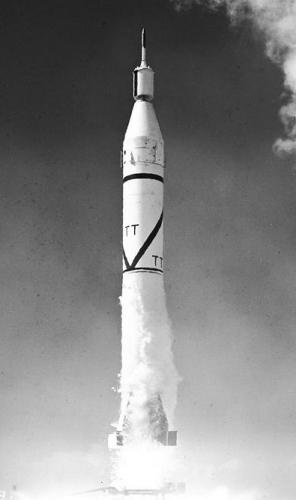ABMA Juno I (Jupiter C)
In mid-1954 the U.S. Army's Redstone Arsenal began "Project Orbiter". This program was to launch an instrumented satellite into orbit, using a modified SSM-A-14 Redstone ballistic missile with a cluster of solid rocket motors as upper stage. However, Project Orbiter was cancelled in 1955, when the DOD officially selected the U.S. Navy's Vanguard program as the nation's first satellite launch vehicle.
At that time, the Army had already begun to develop the Jupiter IRBM (later transferred to the Air Force as the SM-78). The development program by the ABMA (Army Ballistic Missile Agency) included the construction of the Jupiter C, which was a three-stage rocket to test reentry vehicles for the Jupiter missile. The Jupiter C's first stage was the engine of a Redstone missile with an elongated tank. The second and third stages were clusters of eleven and three "Baby Sergeant" solid-propellant rockets, which were mounted in a "tub" on top of the first stage. This tub was spun-up before launch to provide spin-stabilization for the solid stages after separation. The first Jupiter C flight occurred on 20 September 1956, and successfully tested separation and performance of all three stages. Instead of a reentry vehicle, this rocket carried an inert fourth stage. Two more Jupiter C flights were conducted in May and August 1957, the last one successfully verifying the reentry vehicle design for the SM-78 Jupiter IRBM.
 |
 | |
| Photo: U.S. Army | Photo: NASA | |
| Juno I (Jupiter C) | ||
It was clear that the Jupiter C could place a small payload into orbit, if a live fourth stage consisting of a single "Baby Sergeant" rocket were used. In fact, the Army was explicitly forbidden to do so in their Jupiter C flight tests. The reason was that the United States wanted to avoid launching the first artificial satellite with a rocket that was quite obviously a military missile. At that time, the CIA and the Air Force were already planning their first reconnaissance satellite system (WS-117L), and it was absolutely vital that the world's first satellite would set a definitive precedence that an orbital vehicle can legally fly over any part of the world. The best method to ensure this was a "civilian" launch, or, in fact, the enemy launching the first one and the USA not complaining about it. Anyway, things changed when the USSR launched Sputnik on 4 October 1957, and in November the Army was given the go-ahead to launch a satellite with the Jupiter C at the earliest possible date. The failure of the Vanguard on the first satellite launch attempt in December that year further raised the priority of the Jupiter C launch vehicle.
On 31 January 1958, the first four-stage Jupiter C successfully placed the Explorer I satellite into orbit (347 km (216 miles) x 1859 km (1155 miles)) on the first try. The 13.9 kg (30.7 lb) satellite consisted of the burnt-out fourth stage rocket motor and a nose with a 8.3 kg (18.3 lb) payload. The latter consisted of various scientific instruments and a radio transmitter. The most important scientific result of the Explorer I mission was the discovery of the Van Allen radiation belts around the earth.
To distinguish the four-stage satellite launch vehicle from the three-stage Jupiter C, the former was officially named Juno (later amended to Juno I, when the Juno II was created), but that name never quite caught on. The Juno I was used for another five launch attempts until October 1958, two of which (Explorer III on 26 March and Explorer IV on 26 July) were successful. When NASA was officially created on 1 October 1958, it absorbed the ABMA's rocket development team, thus ending military involvement in the Explorer series of satellites.
Specifications
Note: Data given by several sources show slight variations. Figures given below may therefore be inaccurate!
Data for Juno I:
| Length | 21.23 m (69 ft 8 in) |
| Diameter | 1st stage: 1.78 m (5 ft 10 in) 2nd/3rd stage tub: 89 cm (35 in) 4th stage: 15 cm (6 in) |
| Finspan | 3.86 m (12 ft 8 in) |
| Weight | 29000 kg (64000 lb) |
| Payload | 11 kg (25 lb) to LEO |
| Propulsion | 1st stage: Rocketdyne A-7 liquid-fueled rocket; 370 kN (83000 lb) for 155 s 2nd stage: 11x JPL Baby Sergeant solid-fueled rocket; 8.0 kN (1800 lb) each for 6.5 s 3rd stage: 3x JPL Baby Sergeant solid-fueled rocket; 8.0 kN (1800 lb) each for 6.5 s 4th stage: JPL Baby Sergeant solid-fueled rocket; 8.0 kN (1800 lb) for 6.5 s |
Main Sources
[1] Peter Alway: "Rockets of the World", Saturn Press, 1999
[2] T.A. Heppenheimer: "Countdown: A History of Space Flight", Wiley, 1997
[3] Frederick I. Ordway III, Ronald C. Wakeford: "International Missile and Spacecraft Guide", McGraw-Hill, 1960
[4] Explorer Information, NASA
Back to Directory of U.S. Military Rockets and Missiles, Appendix 4
Last Updated: 11 February 2005